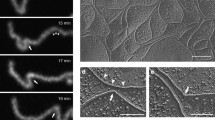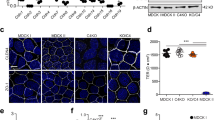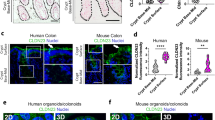Abstract
The tight junction seal formed between epithelial cells varies among tissues in both tightness and ionic charge selectivity. We recently demonstrated that the extracellular domains of the claudin family of proteins are determinants of both characteristics, but in that study other unidentified domains in the claudins clearly contributed to their physiological potency. To investigate the importance of the cytoplasmic carboxyl-terminal domains in determining the degree to which a claudin can influence barrier properties, we constructed chimeras by exchanging the tails of claudin-2 and -4 and expressing them in MDCK II cells. Although swapping these domains had little effect on claudin localization, we found that the tail of claudin-2 could stabilize claudin-4, with a concomitant increase in both protein level and physiologic influence. This difference in stability was not an artifact of their chimeric structure, since metabolic radio-labeling experiments revealed that the half-life of endogenous claudin-2 is more than three times longer than claudin-4 (>12 h and ∼4 h respectively). Further, half-life was not affected by removing the carboxyl-terminal three amino acids, which form a PDZ-binding motif. The finding that cytoplasmic tails of claudins strongly influence stability reveals a potential mechanism by which cells can establish their tight junction protein composition and thus function.








Similar content being viewed by others
References
S. Amasheh N. Meiri A.H. Gitter T. Schoneberg J. Mankertz J.D. Schulzke M. Fromm (2002) ArticleTitleClaudin-2 expression induces cation-selective channels in tight junctions of epithelial cells J. Cell Sci. 115 4969–4976 Occurrence Handle10.1242/jcs.00165 Occurrence Handle12432083
G. Bazzoni (2003) ArticleTitleThe JAM family of junctional adhesion molecules Curr. Opin. Cell. Biol 15 525–530 Occurrence Handle10.1016/S0955-0674(03)00104-2 Occurrence Handle14519386
W. Brieher A.S. Yap B. Gumbiner (1996) ArticleTitleLateral dimerization is required for the homophilic binding activity of C-cadherin J. Cell Biol. 135 487–489 Occurrence Handle10.1083/jcb.135.2.487 Occurrence Handle8896604
Y. Chen Q. Lu E.E. Schneeberger D.A. Goodenough (2000) ArticleTitleRestoration of tight junction structure and barrier function by down-regulation of the mitogen-activated protein kinase pathway in ras-transformed Madin-Darby canine kidney cells Mol. Biol. Cell 11 849–862 Occurrence Handle10712504
O.R. Colegio C. Van Itallie C. Rahner J.M. Anderson (2003) ArticleTitleClaudin extacellular domains determine charge selectivity and resistance but not tight junction fibril architecture Am. J. Physiol. 284 C1346–C1354
O.R. Colegio C.M. Van Itallie H.J. McCrea C. Rahner J.M. Anderson (2002) ArticleTitleClaudins create charge-selective channels in the paracellular pathway between epithelial cells Am. J. Physiol. 283 C142–C147
M. Furuse T. Hirase M. Itoh A. Nagafuchi S. Yonemura S. Tsukita S. Tsukita (1993) ArticleTitleOccludin: a novel integral membrane protein localizing at tight junctions J. Cell Biol. 123 1777–1788 Occurrence Handle10.1083/jcb.123.6.1777 Occurrence Handle8276896
M. Furuse H. Sasaki K. Fujimoto S. Tsukita (1998) ArticleTitleA single gene product, claudin-1 or -2, reconstitutes tight junction strands and recruits occludin in fibroblasts J. Cell Biol. 143 391–401 Occurrence Handle10.1083/jcb.143.2.391 Occurrence Handle9786950
L. Gonzalez-Mariscal A. Betanzos P. Nava B.E. Jaramillo (2003) ArticleTitleTight junction proteins Prog. Biophys. Mol. Biol. 81 1–44 Occurrence Handle10.1016/S0079-6107(02)00037-8 Occurrence Handle12475568
R.O. Hynes (1992) ArticleTitleIntegrins: versatility, modulation, and signaling in cell adhesion Cell 69 11–25 Occurrence Handle10.1016/0092-8674(92)90115-S Occurrence Handle1555235
M. Itoh M. Furuse K. Morita K. Kubota M. Saitou S. Tsukita (1999) ArticleTitleDirect binding of three tight junction-associated MAGUKs, ZO-1, ZO-2, and ZO-3, with the COOH termini of claudins J. Cell Biol. 147 1351–1363 Occurrence Handle10.1083/jcb.147.6.1351 Occurrence Handle10601346
Y. Kiuchi-Saishin S. Gotoh M. Furuse A. Takasuga Y. Tano S. Tsukita (2002) ArticleTitleDifferential expression patterns of claudins, tight junction membrane proteins, in mouse nephron segments J. Am. Soc. Nephrol. 13 875–886 Occurrence Handle11912246
K. Kubota M. Furuse H. Sasaki N. Sonoda K. Fujita A. Nagafuchi S. Tsukita (1999) ArticleTitleCa2+-independent cell-adhesion activity of claudins, a family of integral membrane proteins localized at tight junctions Curr. Biol. 9 1035–1038 Occurrence Handle10.1016/S0960-9822(99)80452-7 Occurrence Handle10508613
L.L. Mitic V.M. Unger J.M. Anderson (2003) ArticleTitleExpression, solubilization, and biochemical characterization of the tight junction transmembrane protein claudin-4 Protein Sci. 12 218–227 Occurrence Handle10.1110/ps.0233903 Occurrence Handle12538885
K. Morita M. Furuse K. Fujimoto S. Tsukita (1999) ArticleTitleClaudin multigene family encoding four-transmembrane domain protein components of tight junction strands Proc. Natl. Acad. Sci. USA 96 511–516 Occurrence Handle10.1073/pnas.96.2.511 Occurrence Handle9892664
S Poliak S. Matlis C. Ullmer S.S. Scherer E. Peles (2002) ArticleTitleDistinct claudins and associated PDZ proteins form different autotypic tight junctions in myelinating Schwann cells J. Cell Biol. 159 361–372 Occurrence Handle10.1083/jcb.200207050 Occurrence Handle12403818
D.W. Powell (1981) ArticleTitleBarrier function of epithelia Am J. Physiol. 241 G275–G288 Occurrence Handle7032321
C. Rahner L.L. Mitic J.M. Anderson (2001) ArticleTitleHeterogeneity in expression and subcellular localization of claudins 2, 3, 4, and 5 in the rat liver, pancreas, and gut Gastroenterology 120 411–422 Occurrence Handle10.1053/gast.2001.21736 Occurrence Handle11159882
J.L. Reyes M. Lamas D. Martin N.M. Carmen S. Islas J. Luna M. Tauc L. Gonzalez-Mariscal (2002) ArticleTitleThe renal segmental distribution of claudins changes with development Kidney Int. 62 476–487 Occurrence Handle10.1046/j.1523-1755.2002.00479.x Occurrence Handle12110008
M. Saitou M. Furuse H. Sasaki J.D. Schulzke M. Fromm H. Takano T. Noda S. Tsukita (2000) ArticleTitleComplex phenotype of mice lacking occludin, a component of tight junction strands Mol. Biol. Cell 11 4131–4142 Occurrence Handle11102513
E. Sonnhammer et al. (1998) A hidden Markov model for predicting transmembrane helices in protein sequences AAAI Press. Int. Conf, Intell. Syst. Mol. Biol. Montreal, Canada 176–182
A. Swiatecka-Urban M. Duhaime B. Coutermarsh K.H. Karlson J. Collawn M. Milewski G.R. Cutting W.B. Guggino G. Langford B.A. Stanton (2002) ArticleTitlePDZ domain interaction controls the endocytic recycling of the cystic fibrosis transmembrane conductance regulator J. Biol. Chem. 277 40099–40105 Occurrence Handle10.1074/jbc.M206964200 Occurrence Handle12167629
A. Traweger D. Fang Y.C. Liu W. Stelzhammer I.A. Krizbai F. Fresser H.C. Bauer H. Bauer (2002) ArticleTitleThe tight junction-specific protein occludin is a functional target of the E3 ubiquitin-protein ligase itch J. Biol. Chem. 277 10201–10208 Occurrence Handle10.1074/jbc.M111384200 Occurrence Handle11782481
C. Van Itallie C. Rahner J.M. Anderson (2001) ArticleTitleRegulated expression of claudin-4 decreases paracellular conductance through a selective decrease in sodium permeability J. Clin. Invest. 107 1319–1327 Occurrence Handle11375422
C.M. Van Itallie A.S. Fanning J.M. Anderson (2003) ArticleTitleReversal of charge selectivity in cation or anion selective epithelial lines by expression of different claudins Am. J. Physiol 285 F1078–F1084
A.S. Yu A.H. Enck W.I. Lencer E.E. Schneeberger (2003) ArticleTitleClaudin-8 expression in MDCK cells augments the paracellular barrier to cation permeation J. Biol. Chem 278 17350–17359 Occurrence Handle10.1074/jbc.M213286200 Occurrence Handle12615928
Acknowledgments
We thank the members of the Anderson laboratory for their critical insights, especially Dr. Alan S. Fanning. These studies were supported by National Institute of Diabetes and Digestive and Kidney Diseases Grants DK45134 and DK55389. O.R. Colegio is a recipient of individual NRSA F31 DK61283.
Author information
Authors and Affiliations
Corresponding author
Rights and permissions
About this article
Cite this article
Van Itallie, C.M., Colegio, O.R. & Anderson, J.M. The Cytoplasmic Tails of Claudins Can Influence Tight Junction Barrier Properties through Effects on Protein Stability. J Membrane Biol 199, 29–38 (2004). https://doi.org/10.1007/s00232-004-0673-z
Received:
Revised:
Issue Date:
DOI: https://doi.org/10.1007/s00232-004-0673-z




